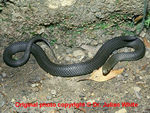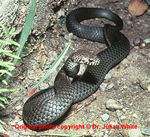|
Austrelaps labialis
|
![Austrelaps labialis ( Adelaide Hills Copperhead ) [ Original photo copyright © Dr Julian White ]](images/snakes/SNP04961.jpg)
|
|
Family: Elapidae
|
|
Subfamily: Elapinae
|
|
Genus: Austrelaps
|
|
Species: labialis
|
Common Names
Adelaide Hills Copperhead , Pygmy Copperhead
|
Region
Australia
|
Countries
Australia
|
|

|
|
|
|
Taxonomy and Biology
|
|
Adult Length: 0.45 m
|
General Shape
Smallest Australian copperhead snake with a moderately robust, strongly muscled body and medium length tail. Can grow to a maximum of about 0.87 metres. Head is moderately small, slightly distinct from neck, with a more rounded and relatively shorter snout when compared to the other two Austrelaps species. Eyes are moderately large in size with round pupils. Dorsal scales are smooth. Lower lateral scale rows ( especially the 1st dorsal scale row ) are distinctly enlarged.
|
Habitat
On the mainland it is found in cooler and wetter areas of dry sclerophyll forests and woodlands. Usually there is an understorey of heath and tussock grasses and nearby stream or seepage area offering permanent or semi-permanent fresh water. On Kangaroo Island it is found in dense heath shrublands, with or without an overstorey of woodland, in wetter coastal or near coastal areas. Also found in urban and semi-urban areas.
|
Habits
Terrestrial and mainly diurnal ( sometimes active at night ). Inoffensive disposition, secretive and shy. If disturbed it will escape to cover. If cornered, it will hiss loudly, flatten its body and often thrash about menacingly without attempting to bite.
|
Prey
Forages for lizards ( mainly skinks ) and frogs.
|
|
|
|
Venom
|
General: Venom Neurotoxins
Possibly present
|
General: Venom Myotoxins
Possibly present but not clinically significant
|
General: Venom Procoagulants
Not present
|
General: Venom Anticoagulants
Possibly present but not clinically significant
|
General: Venom Haemorrhagins
Not present
|
General: Venom Nephrotoxins
Not present
|
General: Venom Cardiotoxins
Not present
|
General: Venom Necrotoxins
Not present
|
General: Venom Other
Not present or not significant
|
|
|
|
Clinical Effects
|
General: Dangerousness
Unknown, but potentially lethal envenoming, though unlikely, cannot be excluded.
|
|
General: Rate of Envenoming: <10%
|
|
General: Untreated Lethality Rate: Unknown but lethal potential cannot be excluded
|
General: Local Effects
Local pain only
|
General: Local Necrosis
Not likely to occur
|
General: General Systemic Effects
Variable non-specific effects which may include headache, nausea, vomiting, abdominal pain, diarrhoea, dizziness, collapse or convulsions
|
General: Neurotoxic Paralysis
Insufficient clinical reports to know
|
General: Myotoxicity
Not likely to occur
|
General: Coagulopathy & Haemorrhages
Unlikely to occur
|
General: Renal Damage
Unlikely to occur
|
General: Cardiotoxicity
Unlikely to occur
|
General: Other
Not likely to occur
|
|
|
|
First Aid
|
|
Description: First aid for bites by Elapid snakes which do not cause significant injury at the bite site (see Comments for partial listing), but which may have the potential to cause significant general (systemic) effects, such as paralysis, muscle damage, or bleeding.
|
Details
1. After ensuring the patient and onlookers have moved out of range of further strikes by the snake, the bitten person should be reassured and persuaded to lie down and remain still. Many will be terrified, fearing sudden death and, in this mood, they may behave irrationally or even hysterically. The basis for reassurance is the fact that many venomous bites do not result in envenoming, the relatively slow progression to severe envenoming (hours following elapid bites, days following viper bites) and the effectiveness of modern medical treatment.
2. The bite wound should not be tampered with in any way. Wiping it once with a damp cloth to remove surface venom is unlikely to do much harm (or good) but the wound must not be massaged. For Australian snakes only, do not wash or clean the wound in any way, as this may interfere with later venom detection once in a hospital.
3. All rings or other jewellery on the bitten limb, especially on fingers, should be removed, as they may act as tourniquets if oedema develops.
4. If the bite is on a limb, a broad bandage (even torn strips of clothing or pantyhose) should be applied over the bitten area at moderate pressure (as for a sprain; not so tight circulation is impaired), then extended to cover as much of the bitten limb as possible, including fingers or toes, going over the top of clothing rather than risking excessive limb movement by removing clothing. The bitten limb should then be immobilised as effectively as possible using an extemporised splint or sling.
5. If there is any impairment of vital functions, such as problems with respiration, airway, circulation, heart function, these must be supported as a priority. In particular, for bites causing flaccid paralysis, including respiratory paralysis, both airway and respiration may be impaired, requiring urgent and prolonged treatment, which may include the mouth to mask (mouth to mouth) technique of expired air transfer. Seek urgent medical attention.
6. Do not use Tourniquets, cut, suck or scarify the wound or apply chemicals or electric shock.
7. Avoid peroral intake, absolutely no alcohol. No sedatives outside hospital. If there will be considerable delay before reaching medical aid, measured in several hours to days, then give clear fluids by mouth to prevent dehydration.
8. If the offending snake has been killed it should be brought with the patient for identification (only relevant in areas where there are more than one naturally occurring venomous snake species), but be careful to avoid touching the head, as even a dead snake can envenom. No attempt should be made to pursue the snake into the undergrowth as this will risk further bites.
9. The snakebite victim should be transported as quickly and as passively as possible to the nearest place where they can be seen by a medically-trained person (health station, dispensary, clinic or hospital). The bitten limb must not be exercised as muscular contraction will promote systemic absorption of venom. If no motor vehicle or boat is available, the patient can be carried on a stretcher or hurdle, on the pillion or crossbar of a bicycle or on someone's back.
10. Most traditional, and many of the more recently fashionable, first aid measures are useless and potentially dangerous. These include local cauterization, incision, excision, amputation, suction by mouth, vacuum pump or syringe, combined incision and suction ("venom-ex" apparatus), injection or instillation of compounds such as potassium permanganate, phenol (carbolic soap) and trypsin, application of electric shocks or ice (cryotherapy), use of traditional herbal, folk and other remedies including the ingestion of emetic plant products and parts of the snake, multiple incisions, tattooing and so on.
|
|
|
|
Treatment
|
Treatment Summary
While some cases will prove minor, copperhead bites are potentially severe (paralysis particularly), so must be assessed urgently. Antivenom is required for systemic envenoming.
|
Key Diagnostic Features
Local pain + flaccid paralysis
|
General Approach to Management
All cases should be treated as urgent & potentially lethal. Rapid assessment & commencement of treatment including appropriate antivenom (if indicated & available) is mandatory. Admit all cases.
|
Antivenom Therapy
Antivenom is the key treatment for systemic envenoming. Multiple doses may be required.
|
| 1. Antivenom Code: SAuCSL10
|
|
Antivenom Name: Tiger Snake Antivenom
|
|
Manufacturer: CSL Limited
|
Phone: ++61-3-9389-1911
Toll free: 1800 642 865
|
Address: 45 Poplar Road
Parkville
Victoria 3052
|
|
Country: Australia
|
| 2. Antivenom Code: SAuCSL12
|
|
Antivenom Name: Polyvalent Snake Antivenom ( Australia - New Guinea )
|
|
Manufacturer: CSL Limited
|
Phone: ++61-3-9389-1911
Toll free: 1800 642 865
|
Address: 45 Poplar Road
Parkville
Victoria 3052
|
|
Country: Australia
|
|
|
|
Images
|

|

|

|

|
|
|
|
Austrelaps labialis ( Adelaide Hills Copperhead ) [ Original photo copyright © Dr Julian White ]
|
Austrelaps labialis ( Adelaide Hills Copperhead ) [ Original photo copyright © Dr Julian White ]
|
Austrelaps labialis ( Adelaide Hills Copperhead ) [ Original photo copyright © Dr Julian White ]
|
Austrelaps labialis ( Adelaide Hills Copperhead ) [ Original photo copyright © Dr Julian White ]
|
|
|
|
|
|



